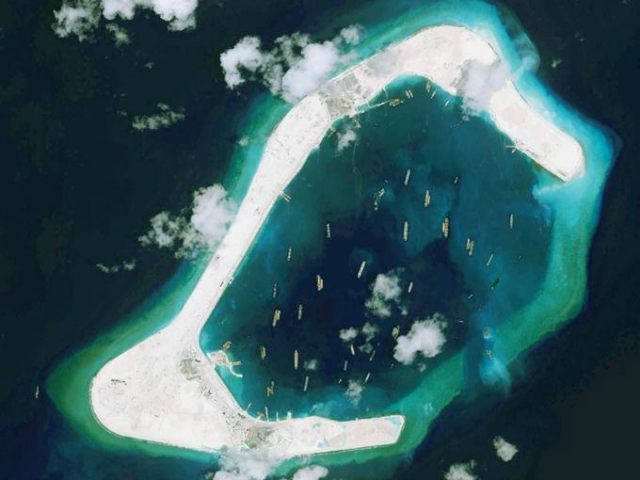A Chinese defense ministry spokesman warned the United States to “be careful” in the South China Sea following declarations from American Deputy Secretary of Defense Robert Work that the U.S. would not respect a unilaterally imposed exclusion zone in the disputed territory.
Chinese Defense Ministry spokesman Yang Yujun was responding to a question during the ministry’s regular daily briefing regarding the disputed territories of the South China Sea and the United States’s repeated assurances it would continue to send its vessels to conduct freedom of navigation exercises in the region, as well as new deals with the government of the Philippines that would bolster America’s presence there. “As for the US ships which came, I can only suggest they be careful,” he told reporters. Yang also condemned the United States for harboring a “Cold War mentality” and going “in the opposite direction of the trends of the era for peace, development and cooperation.”
American officials, meanwhile, asserted Thursday that they are concerned that China may attempt to formally usurp the territories in the region it has begun to colonize and will under no circumstances accept China’s demands. “We don’t believe they have a basis in international law, and we’ve said over and over (that) we will fly, sail and go wherever international law allows,” Deputy Secretary of Defense Work said, adding that any attempt to establish an Air Defense Identification Zone (ADIZ) over disputed territory would be disregarded. “We have spoken quite plainly to our Chinese counterparts and said that we think an ADIZ would be destabilizing,” he said, “We would prefer that all of the claims in the South China Sea be handled through mediation and not force or coercion.”
An ADIZ requires all aircraft entering and exiting the region in question to alert the relevant country to their presence there, allowing for complete control of the skies by the country issuing it. Should an aircraft not identify itself to the ruling nation, it may be subject to inspection or military retribution. China has attempted to impose an ADIZ in disputed waters once before: In 2013, Beijing announced it had imposed an ADIZ in the East China Sea over the Japanese Senkaku Islands. Japan and the United States both asserted they would ignore the requirement to identify their aircraft, which led China to threaten it would take action against unauthorized flights in the area. President Obama issued a statement in mid-2014 asserting that America is treaty-bound to defend Japan against any military attack, meaning that the U.S. was bound to attack any Chinese vessel threatening Japanese aircraft in the region.
The ADIZ remains in place, but China has never exercised its self-declared authority to demand aircraft identify themselves in the region, possibly hoping to avoid any direct military conflict with the United States.
China and Japan dispute parts of the East China Sea. The claims in the South China Sea are much more widespread: China, Taiwan, Brunei, Malaysia, Vietnam, and the Philippines all claim parts of the territory China has unilaterally asserted is its own because of “ancient” activity there. In the greater South China Sea, Indonesia holds sovereignty over Natuna Island, which China does not claim, though Beijing has attempted to assert dominance over the water surrounding it.
Chinese vessels have repeatedly attacked Vietnamese and Philippine fishermen, accusing them of wandering into Chinese waters. Vietnam has posed a unique challenge to China, as the only fellow communist nation involved in this dispute. In an article posted Thursday, the Chinese state-run People’s Daily suggests that China and Vietnam may resolve the dispute through “candid” discussions about their relative interests.
The U.S. State Department will soon be operating out of five major Philippine bases in the region. It is also treaty-bound to defend the Philippines as of 1951. American officials have rarely cited this treaty, but the establishment of a Chinese ADIZ over Philippine territory may rekindle interest in that agreement.
In addition to its presence in the Philippines, America’s Navy has maintained a presence in the region. It has recently executed two freedom of navigation operations in the South China Sea: in October, with the USS Lassen, and in February, with the USS Curtis Wilbur. The head of U.S. Pacific Command, Admiral Harry Harris, has stated plainly that America “will be doing [freedom of navigation exercises] more and we’ll be doing them with greater complexity in the future.”

COMMENTS
Please let us know if you're having issues with commenting.